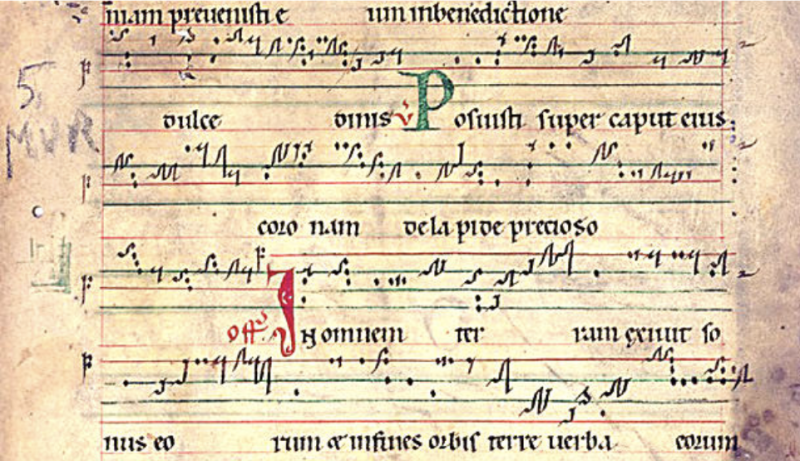Of all living things, only humans seem to have the drive and capacity for documentation, record-keeping, and writing for the purposes of porting information and wisdom to others with the hope of influencing and binding the future.
We’ve done this since the beginning of recorded history, from cave dwellings to the Code of Hammurabi through the Magna Carta and the Declaration of Independence. The motivation is always the same. The purpose of documentation is to establish a norm for the human community. Art is one way and writing is another. But certain kinds of information have proven more difficult.
Music posed a special challenge. Yes, you can teach a song or a sound to another but how does one harness sound, pitch, and rhythm to convey it to others without a physical demonstration?
There are ancient sources that suggest attempts along the way but not very successful ones. The problem was only solved in the 10th century by one of the most brilliant innovators in history: Benedictine monk Guido d’Arrezo (992 – after 1033). His innovation made everything else possible, from Palestrina through Stravinski.
Since ancient times, the teaching of music had been done by a tiny and arrogant cartel of masters. That is because in the first millennium AD, no one could figure out a reliable way to transmit musical ideas except by singing and playing them to each other in person.
In the second millennium, a way emerged: the printed musical staff. It was a form of technology and it laid the foundation for astonishing innovations, beginning with polyphonic music, then symphonic music, then popular music, and the dizzying array of choices of all styles that surround us today.
As with all inventions, the invention of the musical staff came in stages. There were viable attempts at writing music from the 6th to the 9th century, which, to people like me, look no more revealing than chicken scratch.
Then there was a breakthrough. Guido d’Arezzo invented a written system of notes and staffs, and also the organization of scales that allowed for teaching and writing music. Without his contribution, the streaming music you hear on your smartphone and YouTube would not likely exist.
Consider the technical feat that Guido undertook. Imagine a world without printed music. How would you go about conveying a tune in printed form? It’s one thing to render words on paper in a way that others can read them. But what about music? It floats in the air and resists having a physical presence at all.
Guido proposed a system with lines and scales that precisely illustrates for the eye what the voice is to sing. He took known information about where half steps and whole steps are in the Western scale (which can be rendered mathematically) and marked them on lines. The clef sign he used to show where the half step is, and the rest of the scale follows from that.
Essentially, he created a physical map of sound space. The rhythms were already in an innovative stage, so he displayed those on the staff. We had precision for the first time.
Guido adapted an existing song to illustrate the scale: Ut Queant Laxis, a hymn to St. John the Baptist, who was then considered the patron saint of singers. On the first syllable of each ascending note, the words were Ut, Re, Mi, Fa, Sol — the very foundation of music pedagogy to this day: do, re, mi, etc., as you know from the song in “Sound of Music.”

His innovation was a beautiful integration of art and science. But it was more than that. Since ancient times, the teaching of music had been controlled by a tiny and arrogant cartel of masters. The choir master ruled the monastery, determining the talent hierarchy and position of every singer within it.
You had to sing exactly as they instructed you. If they weren’t around, you were stuck. They held the monopoly. To become a master of music, you had to study under one of the greats, and then receive the blessing to become a teacher yourself, overcoming the masters’ interest in limiting their numbers. You’d have to be sycophantic to even get your foot in the door.
Guido had become seriously annoyed at the chant master cartel and the power it exercised. He wanted the chant to be freed and put into the hands of everyone both inside and outside the monastery walls.
For this reason, his first great project was a notated Antiphoner, a book of melodies. He wrote:
For, in such a ways, with the help of God I have determined to notate this antiphoner, so that hereafter through it, any intelligent and diligent person can learn a chant, and after he has learned well part of it through a teacher, he recognizes the rest unhesitatingly by himself without a teacher.
He goes further. Without a written form of music, “wretched singers and pupils of singers, even if they should sing every day for a hundred years, will never sing by themselves without a teacher one antiphon, not even a short one, wasting so much time in singing that they could have spent better learning thoroughly sacred and secularly writing.”
As a result of his innovation, you might think he would have been celebrated. Instead, his monastery in Pomposa, Italy tossed him out into the snow at the urging of the chant masters who wanted to maintain their power. The problem was that elite musicians resisted his attempt to democratize knowledge and skill.
Legend has it that he then went to the Pope, who was very impressed at his innovation and gave him a letter of support. With the letter in hand, he went to the Bishop of Arezzo, who took him in so that he could continue his preaching and his work.
This story illustrates a general pattern in the history of technology. There are those who believe that innovation is for everyone and ought to be accessible to all — that everyone should be permitted to have access to the forms and structures that make for progress. This side loves technical innovation not for its own sake but in the service of great goals.
Then there is the other side, which is reactionary, hates change, wants to reserve technical forms to a tiny elite, fears freedom, detests the idea of human choice, and advances a kind of Gnosticism over technical forms, which are to remain the private preserve of the elite who appoint each other and operate as a kind of guild. This Gnostic guild wants to guard and exclude and privatize, and the people are ultimately their enemy.
This perspective hearkens back to the ancient world where priests served the throne, and sparingly handed out religious truth to the masses based on what they believed they should know in the service of their agenda. One can detect these two tendencies from all ages. Especially in our times.
A millennium later, Guido’s innovation is still with us! Now, here is a paradox. Though his innovation was revolutionary, he was a “conservative” by temperament. He favored the chant, and the preservation of the chant, and didn’t have much affection even for part writing; that is, more than one sound sounding at a time.
Indeed, it’s rather amusing that in his last book on music, he nowhere mentions the existence of early multi-part music, though it had become very popular by the time of his death. He must have thought of it as corrupt and decadent, the way some people think of the latest pop music today.
His personal goal was preservation. But the social effect was to dramatically upset the status quo, cause tremendous professional upheaval, inspire even more innovation, and ultimately make the world a more beautiful place. He did not experience a life reward for this but he fundamentally changed the historical trajectory of music forever.
What lessons can we draw? The status quo is often dominated by cartels that hold us back to methods, strategies, and presumptions that benefit elites rather than common people. Breaking out of that requires genius but also can make you a target of the establishment.
Certainly Elon Musk knows this but also many medical doctors, canceled theorists and practitioners, and writers of all sorts have had hell visited upon them for dissenting from the ways of the elites.
The salient fact of our times is the egregious failure of the elites to do the very thing they promised: give us health, security, and protection from danger. They were granted a free hand to manage the whole world and they made of their opportunity a huge disaster. Meanwhile, the dissidents pushing early treatments, human rights, free speech, and different ways generally have been punished.
The example of Guido d’Arezzo reveals the reason why the dissidents must continue their work. They have the future to win.
Published under a Creative Commons Attribution 4.0 International License
For reprints, please set the canonical link back to the original Brownstone Institute Article and Author.



